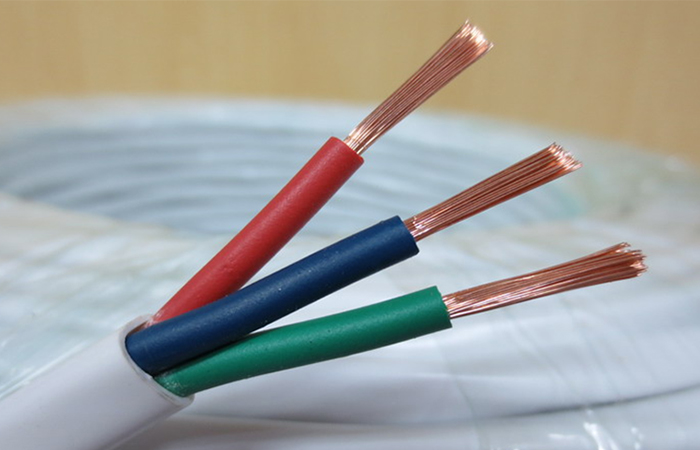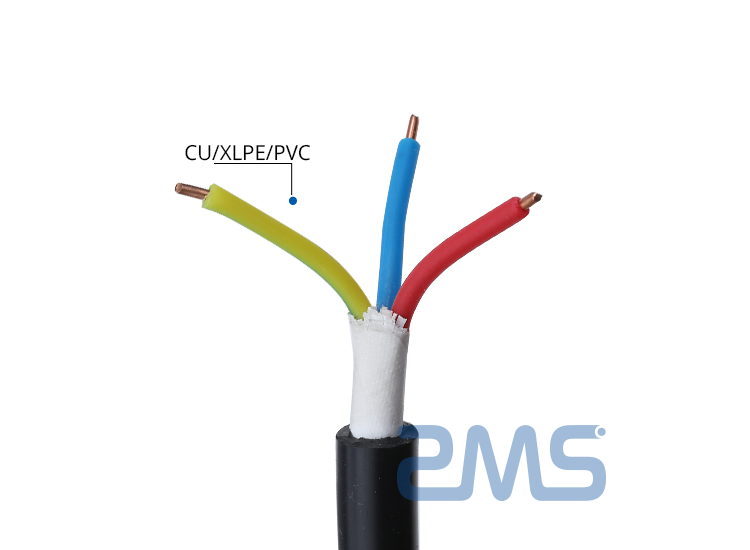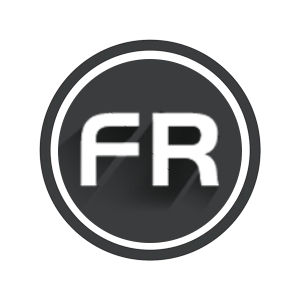3심 케이블은 장치와 기계를 주전원에 연결하는 데 도움이 됩니다..
사용하기로 선택한 3심 케이블의 크기와 회로 설계 방식도 프로젝트에 영향을 줄 수 있습니다.
응용 프로그램의 차이와 프로젝트 사양의 변형으로 인해.
추가적으로, 고전압 애플리케이션에는 종종 고품질 케이블이 필요합니다., 강철 와이어 갑옷으로 알려진 (SWA), 적용 가능한 표준 및 사양.
그러므로, 3심 아머드 케이블 색상에 대해 잘 알고 있어야 합니다., 각 색상의 도체는 무엇을위한 것입니까?.
이 게시물에서, 우리는 이 모든 문제에 대해 더 자세히 논의할 것입니다.
3코어 케이블이란??
사용할 전선이나 케이블의 유형을 아는 것이 중요합니다..
어떤 전기 응용 분야에서 작업하려고 하든 관계 없습니다..
다양한 목적으로 매우 인기 있는 선택은 3코어 케이블입니다..
이 케이블에는 세 가지 전기 전송 목적을 위한 세 개의 별도 코어가 포함되어 있습니다..
예를 들어, 1.5mm를 사용하기로 선택한 경우 3-코어 플렉스 케이블, 메인 케이블 재킷 내부에는 별도의 와이어 3개가 있습니다..
전선 중 하나는 전원 공급용입니다., 다른 하나는 중성선용입니다., 3코어 케이블의 세 번째 와이어는 접지용입니다. (또는 접지) 애플리케이션.
다른 유형의 전선의 관점에서 위의 정보를 검토하는 것이 도움이 될 수 있습니다..
3심 케이블과 달리, 2-코어 케이블에는 도체가 하나 더 적습니다.. 어셈블리는 두 개의 코어로만 구성됩니다..
그래서, 10mm 3코어 아머드 케이블에는 라이브, 중립적, 그리고 접지 (또는 접지) 철사, 동일한 케이블의 해당 2코어 버전에는 접지 도체가 없습니다.. 라이브 및 중성 도체만 있습니다..

3코어 접지선의 용도는 무엇입니까??
일반적으로 주거용 양방향 조명과 같은 응용 분야에 사용됩니다., 다른 응용 프로그램에서도 마찬가지로. 중앙 난방 시스템 및 장비 배선 등.
전기 기술자가 양방향 조명용 회로를 어떻게 설계하느냐에 따라.
3코어 및 접지 케이블에는 중성 또는 라이브 애플리케이션이 있을 수 있습니다..
일반적으로, 3코어 케이블은 3개의 별도 구리 코어가 있는 와이어를 의미합니다., 각각 자체 보호 재킷 안에 있음.
하지만, 3심 접지선용, 네 번째 도체는 제조 과정에서 삽입됩니다.
예를 들어, 일반적인 3코어 플렉스 케이블은 일반적인 3코어를 갖습니다., 라이브를 포함해, 중립적, 그리고 접지, 하지만 또 다른 지휘자(네 번째 지휘자)도 갖게 될 것입니다..
이 추가 코어는 일반적으로 접지 목적으로 베어 구리로 되어 있습니다..
위의 예에서 , 3코어 플렉스 케이블을 사용한다면 여분의 나동 도체, 네 번째 도체는 녹색/노란색 코드 슬리브에 삽입되어야 합니다. (지면) 설치 중.
전기 애플리케이션용 3코어 아머드 케이블
코어 기갑 케이블은 일반적으로 3코어 강철 와이어 기갑 케이블로도 알려져 있습니다. (SWA) 케이블.
예를 들어, Armored Cable 16mm라는 사양이 표시될 수 있습니다. 3 코어, BS546/BS6724.
이는 케이블이 특정 영국 케이블 제조 및 테스트 표준의 요구 사항을 충족한다는 것을 의미합니다..
3개의 코어 아머드 케이블은 다음과 같이 알려져 있습니다. 전원 및 보조 제어 케이블.
3코어 전원 케이블이라고도 함, 이 케이블은 내마모성 케이블이며 케이블이 손상될 수 있거나 UV 노출 위험이 있는 응용 분야에 사용됩니다..
일반적인 3심 강철 와이어 외장 케이블 (SWA) 외부 전기 애플리케이션에 이상적입니다..
이러한 응용 프로그램은 종종 자연의 힘을 견뎌야 하기 때문에, SWA 실외 3코어 케이블에는 추가 외부 피복이 있습니다. (보통 철망사)
이러한 3심 케이블의 내부 코어에 더 큰 기계적 보호 기능을 제공합니다..
무엇 나는 티3코어 씨할 수 있는 유sed for?
앞서 언급했듯이, 3도체 케이블은 케이블 제조 과정에서 3개의 도체를 포함하는 케이블입니다..
각 유형의 케이블은 서로 다른 용도로 사용됩니다., 특정 목적의 애플리케이션에는 권장하지 않습니다..
예를 들어, 당신의 이상이 1mm 3심 케이블이라면, 더 두껍거나 더 얇은 케이블로 전환하여 사용하는 것은 최선의 방법이 아닐 수 있습니다..
일반적으로, 3-코어 케이블은 일반적으로 장비에 대한 클래스 I 연결에 선택되는 케이블입니다..
그런 장치들 때문에 (또는 관련 응용 프로그램) 지구와의 연결을 제공해야 합니다.

2코어 케이블과 3코어 케이블 비교
이러한 응용 분야에서는 3코어 케이블 대신 2코어 와이어를 사용하면 설치에 영향을 미칠 수 있습니다.. 접지하지 않으면 사용자가 다음에 노출될 수 있습니다. 감전.
접지가 필요하지 않은 경우 전기 기술자는 3코어 케이블 대신 2코어 버전의 케이블을 사용할 수 있습니다..
예를 들어, 클래스 II 장비 항목과 관련된 응용 프로그램에서, 엔지니어나 전기 기술자는 3심 편조 케이블 대신 2심 편조 케이블을 사용할 수 있습니다..
이렇게 사용하는 이유는 Class II 장비는 일반적으로 접지 연결이 필요하지 않기 때문입니다..
요약하자면, 케이블은 종종 장비나 가전제품을 접지해야 하는지 여부에 따라 달라집니다..
전기 코드에 따르면, 인클로저 클래스 I 기기 접지되어야합니다.
이를 위해, 3코어 전원 코드를 사용하세요. 반면에, 2도체 케이블을 사용하는 것은 Class II 애플리케이션에 안전합니다..
활선이 장비 본체나 기기에 닿을 경우 감전의 위험이 더 큰 응용 분야, 3코어 접지 케이블을 권장합니다..
예를 들어, 본체가 비전도성 재료로 만들어진 경우, 고무와 같은, 플라스틱, 유리, 또는 세라믹, 3심 케이블을 사용할 필요가 없을 수도 있습니다..
하지만, 금속과 같은 외부 전도성 2도체 전선 대신 실외 3심 케이블을 선택하는 것이 안전할 수 있습니다., 강철, 철, 또는 구리.
비전도성 애플리케이션에는 2도체 케이블을 사용할 수 있습니다., 단, 전구 소켓에는 3심 케이블을 사용해야 합니다., 가로등 기둥, 감전 위험이 높은 기타 사용 사례.
일반적으로, 3-핵심 강철 와이어 기갑 케이블 (SWA) 지하에서 전력을 전송하는 데 사용됩니다., 발전원에서 주거지 또는 상업 장소까지.
다른 장갑제품도 보실 수 있습니다, 3코어 4mm 장갑 케이블 등, 머리 위 송전 응용 분야에서 전차선과 함께 사용됨.
자주, 일반적인 전기 응용, 조명 스위치나 가전제품의 전원 코드 등, 3코어 플렉스 케이블과 같은 유연한 와이어를 사용할 수 있습니다..
이는 케이블을 사용하면 부러지거나 쪼개질 위험 없이 케이블을 구부리고 비틀 수 있기 때문입니다..
3심 케이블의 색상
2선 및 3심 케이블 모두 특정 색상 요구 사항이 있습니다..
3월 2004, 영국표준 학사 7671 전기 설비를 다루면서 일부 변경이 이루어졌습니다. 2- 영국의 경우 3코어 색상.
이 기준에 대한 변경 사항은 4월부터 적용되었습니다. 1, 2004.
예를 들어, 4월 1일 이전, 25mm 3코어 외장 케이블을 다양한 색상으로 판매하는 케이블 제조업체를 볼 수 있습니다., 하지만 새로운 표준이 발효된 후에는, 그것은 불법이다 (4월부터 1, 2006) 오래된 색상 구성의 케이블을 판매하거나 사용하려면.
3월까지 2004, 3심 접지선의 색상 기준은 파란색이었습니다., 노란색, 빨간색, 접지선 포함.
하지만, 3월 이후 2004, 새로운 3심 케이블 색상은 회색입니다., 검정색과 갈색뿐만 아니라 흙색.
이러한 색상 표준은 하루아침에 적용되지 않습니다. – 2년이 겹치네요 (유예 기간) 전환 전.
이 기간 동안, 소매점 판매 2- 3코어 아머드 케이블, 다른 유형의 3선 제품도 마찬가지입니다., 기존 및 새로운 착색 시스템 모두.
이 채색 표준이 변경된 이유?
주로 EU의 나머지 국가와 일치하도록 케이블 색상을 유지하기 위해 변경되었습니다..
이제 영국뿐만 아니라 모든 유럽 국가에서 통일된 색상 코드가 적용됩니다.
새로운 시스템 하에서, 귀하의 애플리케이션에 3심 플랫 케이블과 같은 제품이 필요한 경우, 새로운 시스템에서는 대륙 전체의 색상 코드만 판매됩니다..



